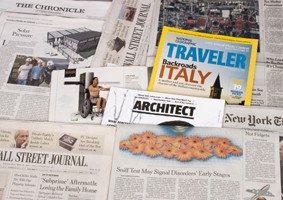
UC Research Wins World Headlines
The University of Cincinnati stands among the nations top 25 public research universities in the United States, according to the National Science Foundation.
That research leadership has translated into increased research support from federal agencies, private industry and others in recent years. Today, it was reported that external support for research at UC for fiscal year 2007 hit an all-time high of $333.5 million. Thats a 28 percent jump from just five years ago when external funding for research at UC stood at $260 million in fiscal year 2002.
Not surprisingly, The Chronicle of Higher Education lists the university in the most prestigious very high category in terms of research activity as reported by the Carnegie Foundation. And at various points throughout 2007, the Chronicle also covered individual UC research projects projects as diverse as a $5.5 million bequest to research Parkinsons disease as well as a back-cover feature on UCs prestigious solar house project (which was also covered by National Public Radio, USA Today and BusinessWeek).
A glance over other research headlines earned by UC during the past few months also makes the case regarding the universitys prominence in important areas of applied research, ranging from disease and drug testing to computer technology and space exploration.
Often, in UCs collaborative environment, such investigative fields overlap as in research covered by Scientific American magazine that involved computer software used in the hope of one day coaxing stem cells to develop into human eyes in the lab or UC/NASA tests to determine if robotic technology is key to provide adequate medical care for astronauts during extended flights.
UC research collaboratives are exemplified by ongoing work between Bob Frank, professor of psychology, and Bob Gesteland, professor emeritus of cell biology, neurology and anatomy, and their sniff-magnitude test developed to provide a potential warning regarding a patients likelihood for developing Alzheimers and other neurological diseases. That work was recently featured in The New York Times, The International Herald Tribune and Popular Science as well as on CNN.
Similarly, John Hancock, professor of architecture, saw his efforts to use visualization technology to recreate historical sites featured in The Wall Street Journal along with other top-rank media, including USA Today, The Washington Post, Los Angeles Times, Chicago Tribune as well as CBS and ABC along with outlets as far away as Egypt.
Even student research work at UC received prominent coverage. Design student Ryan Eders senior-thesis research and conceptual design that promises better workouts for those in wheelchairs was featured by BusinessWeek and The Discovery Channel.
Likewise, computer science and engineering student Julia Taylor and Lawrence Mazlack, coordinator of the universitys Applied Artificial Intelligence Laboratory, saw their project to develop computer software that understands jokes (important since we rely on computers more and more even though computers cannot fully handle the way humans communicate) was featured in newspapers like the Los Angeles Times and in publications as far away as Australia and India.
All of the attention seems a natural, according to Sandra Degen, vice president of research at UC. She said, The sheer amount and variety of media attention is a fitting tribute to the quality of research and education in our nationally and internationally recognized programs. Its due to the students, faculty, curriculum demands and opportunities we provide and partnerships we seek out. All combine for a big impact on how people live today and improving all of our lives for tomorrow.
UCs research impact on the world does indeed range widely: U.S. News & World Report, The Washington Post, The New York Times and other outlets provided coverage to UC work on numerous occasions in past months. For instance, outlets as diverse as BBC News, United Press International and Scripps Howard News Service featured research by Grace LeMasters, professor of environmental health, and colleague James Lockey, professor of environmental health, that suggests firefighters are at a far higher risk of developing certain cancers.
Meanwhile, USA Today covered UC projects as varied as work by stroke researcher Dawn Kleindorfer, associate professor of clinical neurology, along with a study on stalking by Bonnie Fisher, professor of criminal justice.
The international and national headlines earned by the universitys research contributions are matched by regional attention from the likes of The Cleveland Plain Dealer covering UC research on recidivism rates, climate change and DNA evidence along with The Columbus Dispatch covering UC research related to bridge safety and mental health in prisons.
And locally, UCs research has been frequently noted, earning the university prominent headlines by the hundreds from Cincinnati-area news media.
- Read more from UC's latest research report from fiscal year 2007.
Related Stories
Critics fear public-records proposal could make Ohio police...
April 25, 2025
UC Law Professor Mark Godsey discusses a proposed Ohio state budget bill that includes language that could limit the public’s access to law enforcement records due to a range of new exemptions for public records requests. Godsey is director of the Ohio Innocence Project.
Album by CCM faculty featured in the New York Times
April 25, 2025
Four CCM faculty members were recently highlighted in a New York Times roundup of notable new classical music albums. Entitled "5 Classical Music Albums You Can Listen to Right Now," the article spotlights the new album of Beethoven's string quartets performed by the Ariel Quartet, which has served as CCM's string quartet-in-residence since 2012. The ensemble is comprised of four CCM faculty members: Alexandra “Sasha” Kazovsky, violin; Amit Even-Tov, cello; Gershon Gerchikov, violin; and Jan Grüning, viola.
University of Cincinnati professor weighs in on Butler County’s...
April 25, 2025
The University of Cincinnati’s Michael Jones was featured in a Journal-News article that details Butler County’s potential hiring freeze and how the county has been managing its budget since the pandemic. The report, also featured on Cincinnati’s WCPO, explained why County Commissioner Don Dixon finds the current economic conditions “terrifying” and warranting major cost-cutting measures.
